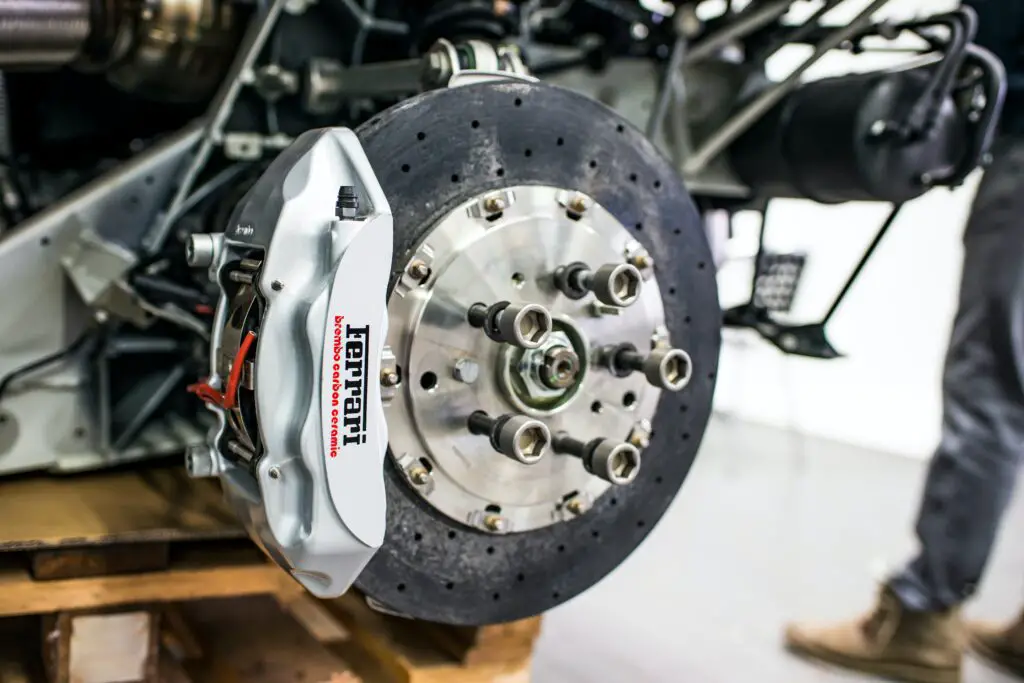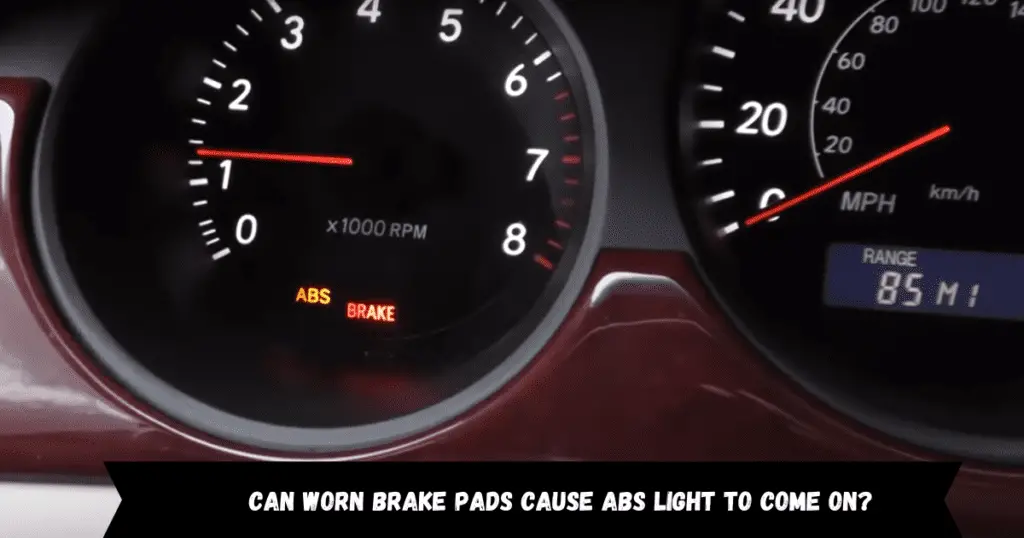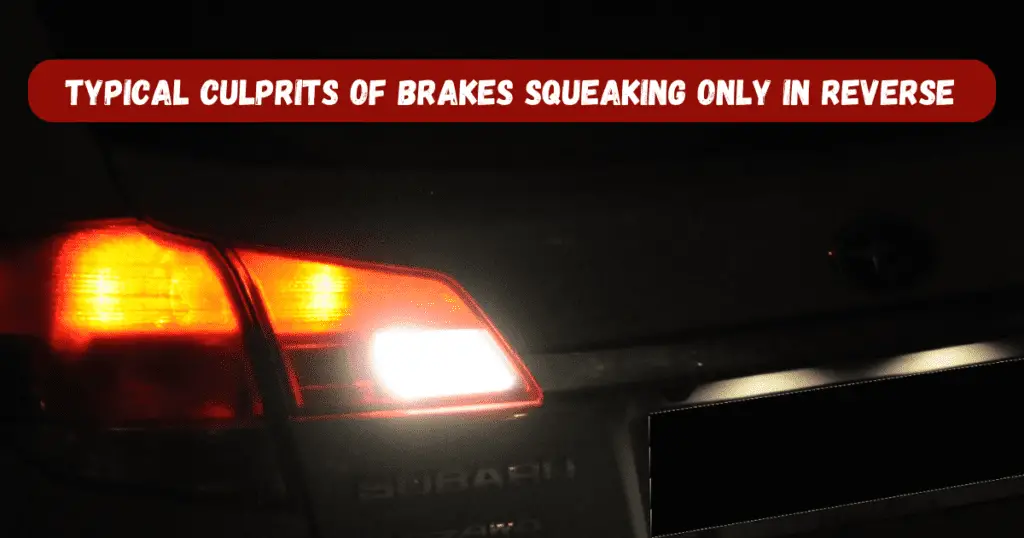A brake hose is a crucial component in any vehicle’s braking system. It carries brake fluid from the master cylinder to the brake calipers at each wheel. Without properly functioning brake hoses, your vehicle’s braking performance will suffer.
Brake hoses endure extreme stresses – engine heat, road vibrations, and hydraulic pressure. Over time, they can develop cracks, bulges, leaks, and other problems. Identifying Signs of a Bad Brake Hose early is key to maintaining safe braking.
This comprehensive guide will cover all the signs, symptoms, causes, and solutions for faulty brake hoses. We’ll also look at related issues like collapsed brake lines, caliper sticking, hose life expectancy, etc.
What is a Brake Hose?
Before jumping into brake hose problems, let’s review what brake hoses are and how they work:
- Brake hoses are flexible rubber or steel-reinforced hoses that connect the rigid brake lines to the wheel cylinders or calipers.
- They carry pressurized brake fluid from the master cylinder to the brakes at each wheel to slow and stop the vehicle.
- Brake hoses must withstand hydraulic pressure while also flexing during wheel movement and suspension travel.
- Most are made of multiple layers – an inner Teflon liner, surrounded by reinforcement fabric, and then a protective rubber cover.
- Hose sizes range from 3/16″ to 1/4″ in diameter for most passenger vehicles.
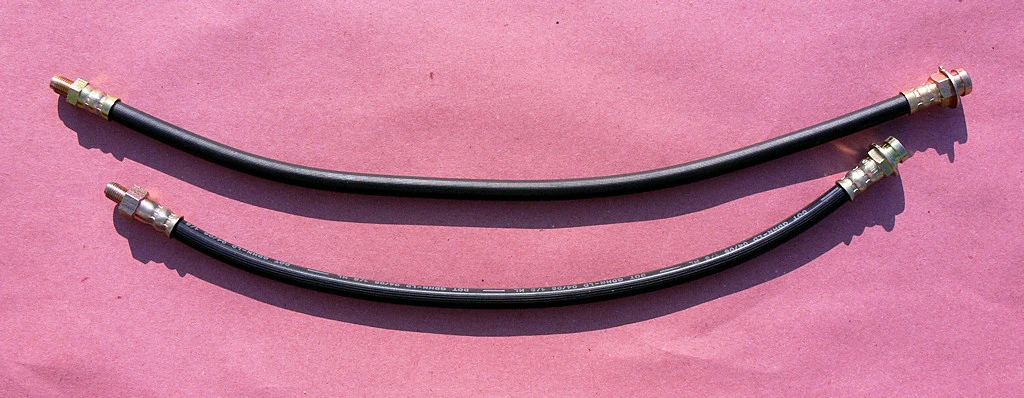
Signs of a Bad Brake Hose
Watch out for these key indicators that your brake hose needs replacement:
1. Brake Fluid Leaks
The most obvious sign of a bad brake hose is fluid leakage. Inspect the hoses closely if you see dripping brake fluid on the ground or wheels. Look for cracks, bulges, or swelling that indicate a leak source. Leaks will only get worse over time if not addressed.
2. Spongy Brake Pedal
Air in the brake lines will make the pedal feel soft instead of firm. Air entry points include cracked hoses, loose fittings, and low fluid levels from leaks. This spongy sensation means your braking power is compromised.
3. Uneven Braking
If one brake hose has failed, the braking on that wheel will be reduced. This can cause the vehicle to pull, drift, or turn to one side when braking. Uneven braking is dangerous and makes the car harder to control.
4. Brake Warning Lights
Signs of a Bad Brake Hose. Modern cars have dashboard warnings when brake fluid levels get too low. This is often caused by a leak in a hose or line. Don’t ignore this serious warning light – have the brake system inspected right away.
5. Brake Judder or Vibration
Damaged hoses can restrict hydraulic flow to the brakes. This may cause uneven pad wear, brake drag, overheating, and vibrations when stopping. If you feel strong shaking in the brake pedal or steering wheel when braking, faulty hoses could be the culprit.
6. Brake Noise
As hoses weaken over time, they can collapse internally and restrict brake fluid flows. This may result in brake noise as the pads drag or stick against the rotors. Squeaking, grinding, or humming noises when braking can signify hose problems.
7. Slow Brake Pedal Return
Brake pedals should retract quickly once pressure is released. Slow return movement can mean brake fluid is stuck inside a swollen hose. This will make the next braking application feel spongy or weak.
8. Hard Brake Pedal
A brake pedal that feels too firm and requires extra effort to press down can indicate issues like a stuck caliper or vacuum leak. But it may also be caused by a collapsed hose restricting proper fluid flow to the brakes.
What Causes Brake Hoses to Fail?
Signs of a Bad Brake Hose. Several factors that can lead to brake hose damage and failure over time:
Age and Wear
Like any rubber component, brake hoses will naturally degrade and weaken with age and use. The inner liner may crack while the outer rubber becomes brittle and prone to cracking. Most hoses last 5-10 years before replacement is needed.
Extreme Temperatures
Engine heat, braking heat, and temperature cycles fatigue the rubber and cause it to dry out faster. Hoses exposed to very hot or very cold conditions will wear out quickly.
Road Salt and Chemicals
Salt, oils, fluids, and other chemicals on roadways can seep through rubber hoses. This contributes to inner liner corrosion and breakdown.
Chafing and Wear
Improper routing or suspension vibrations may cause hoses to rub against chassis parts. This abrades the outer rubber and exposes inner reinforcement.
Hydraulic Pressure
The high fluid pressures needed for braking put strain on hoses over time. Weak spots will balloon or burst under pressure.
Improper Fluid
Using the wrong brake fluid type can swell and degrade the inner liner. Silicone-based fluids are the worst contaminant for brake hoses.
Related Problems
Signs of a Bad Brake Hose. Bad brake hoses don’t happen in isolation. Their failure impacts other brake components and the overall performance of your braking system. Some related issues to watch for include:
- Caliper Sticking: Damaged hoses can allow proper hydraulic flow to the caliper when braking, but then not retract fully once the pedal is released. This leads to caliper pistons sticking out and brake drag.
- Brake Line Collapse: Internal corrosion causes metal brake lines to eventually weaken and restrict fluid flow. Collapsed lines have the same effect as bad hoses by reducing braking capacity.
- Brake Fluid Contamination: Leaks, moisture ingress, and fluid breakdown will contaminate your brake fluid over time. Bad fluid can accelerate hose and line corrosion.
- Uneven Pad Wear: Restricted hoses alter hydraulic pressures to the brake pad. This can result in uneven pad deposit on the rotor, causing vibrations.
- Brake Overheating: Poor hydraulic flows cause brake components to overheat during repeated or heavy braking. This accelerates the wear of pads, rotors, and other parts.
How Long Should Brake Hoses Last?
Brake hoses are considered “wear items” that need routine replacement every few years. Here are some estimates on average brake hose lifespans:
- Rubber hoses – need replacement every 4-6 years.
- Stainless steel hoses – last 8-10 years or more.
- Harsh driving/climate – reduces hose life by 1-2 years.
- Mileage – rubber hoses should be good for about 70,000 miles.
Follow your vehicle manufacturer’s recommendations on inspecting and replacing brake hoses. Generally, every 2-3 years is a good interval to have your brake hoses checked.
When Should Brake Hoses Be Replaced?
Signs of a Bad Brake Hose. Don’t wait for complete brake hose failure before having them changed. Here are signs it’s time for replacement:
- Visible cracking, bulging, swelling, or leaks
- Inner corrosion causing external rust weeping
- Hardening, stiffness, or brittleness in the hose
- Brake fluid seepage at the hose ends
- Reduced braking performance or uneven braking
Replacing bad brake hoses along with a fluid change is smart preventative maintenance. It ensures the safety of your brake system for years to come.
How Much Does It Cost to Replace a Brake Hose?
Brake hose replacement costs vary by vehicle, but on average you can expect to pay:
- $100-$150 per hose (parts & labor)
- $250-$500 to replace all 4 hoses
- Additional charges if other worn parts need replacement at the same time
The labor takes less than an hour per hour in most cases. But costs add up quickly if additional components like calipers or brake lines also need attention.
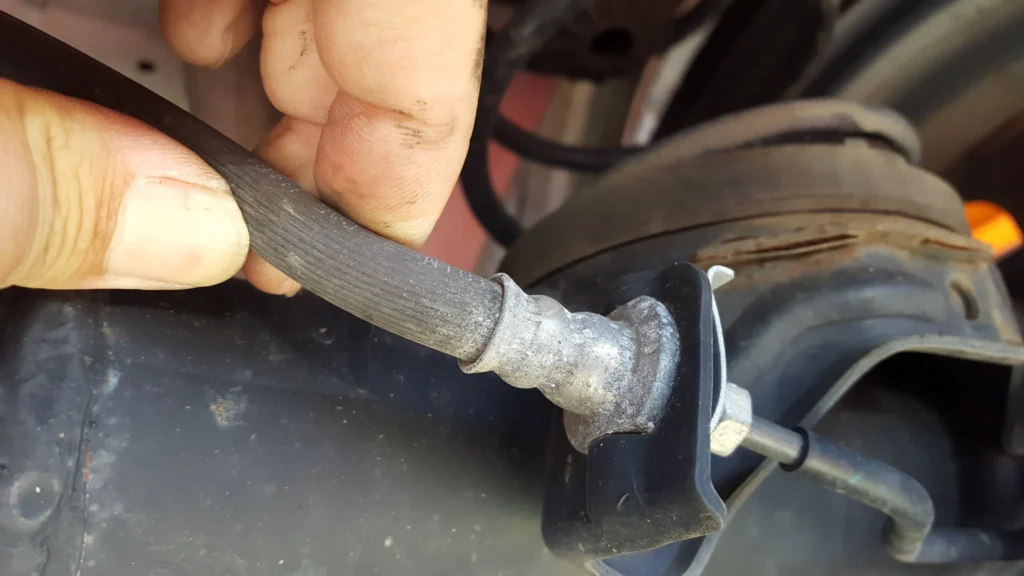

Step-by-Step Brake Hose Replacement
Replacing a brake hose yourself requires brake system bleeding skills and mechanical know-how. But it can save on labor costs if you’re comfortable DIYing. Follow these key steps:
1. Raise and Support the Vehicle
Use jack stands for access to the brake hose area. Never rely on a jackalone.
2. Clean Hose Connections
Remove dirt and debris from the line fittings so no contamination enters the hydraulic system.
3. Loosen Fittings and Remove Hose
Use the correct size line wrench to detach the hose from its brake line and caliper fittings. Plug the open ports.
4. Install New Brake Hose
Route the new hose identically to the old one with no tight bends or kinks. Hand-tighten all fittings only.
5. Tighten Fittings
Once the hose is aligned properly, tighten the fittings to their factory torque specs using a torque wrench.
6. Refill Brake Fluid Reservoir
Top off the master cylinder reservoir with fresh, clean brake fluid to the “Full” mark.
7. Bleed Brakes
Bleed the brakes at all 4 wheels to remove any air introduced during the work.
8. Road Test Vehicle
Test braking performance before regular driving. Fully burnish pads and rotors with repeated stops.
Be extremely careful working around hydraulic brake components. Proper bleeding procedures must be followed to prevent brake failure and accidents. Consider having a professional mechanic complete the brake hose replacement if you lack experience.
FAQs – Signs of a Bad Brake Hose
Here are answers to some frequently asked questions about faulty brake hoses:
How do I know if my brake hose is bad?
Look for external cracks, bulges, leaks, stiffness, or swelling. Brake problems like a spongy pedal, pulling, and loss of pressure indicate a bad hose.
How do you know if your brake hose is leaking?
Check underneath the car and at the wheels for wet spots. Brake fluid leaking from a hose will be clear or light brown. Low fluid levels also confirm a leak.
What is the most likely cause of brake hose failure?
Age and high mileage are the most common factors leading to cracked, dried-out hoses. However, damage from road debris, temperature extremes, and improper routing also cause early failure.
Can a bad brake hose cause a hard pedal?
Yes, a collapsed hose that only allows brake fluid flow in one direction will cause a firm, non-retracting pedal after braking.
How do you test a brake hose?
Visually inspect for damage or leaks first. Then check for pedal softness, dragging brakes, pulling, vibration, or slow pedal return during test drives. These indicate problems inside the hose.
When should I replace my brake hose?
Follow your vehicle maker’s recommended brake hose replacement intervals, usually every 4-6 years for rubber hoses. Inspect annually and replace any hose that’s cracked, leaking, or ballooned.
Protect Your Brakes with Proper Hose Replacement
Signs of a Bad Brake Hose. Brake hoses endure punishing conditions to deliver the hydraulic force needed for safe, consistent braking. But like any component, they eventually wear out. Routine hose inspection and replacement is critical to brake health and your driving safety.
Watch for the telltale signs of a bad brake hoses like fluid leaks, soft pedal feel, and uneven braking. Repairing or replacing damaged hoses immediately will give you peace of mind on every drive. With properly working hoses, your vehicle braking system will stop smoothly and swiftly for years to come.

